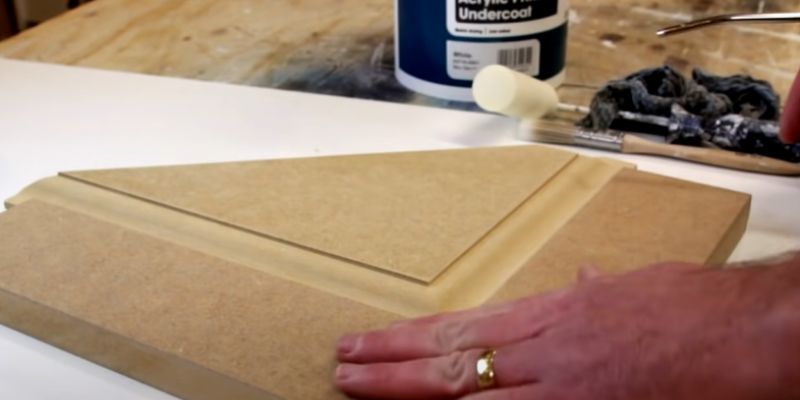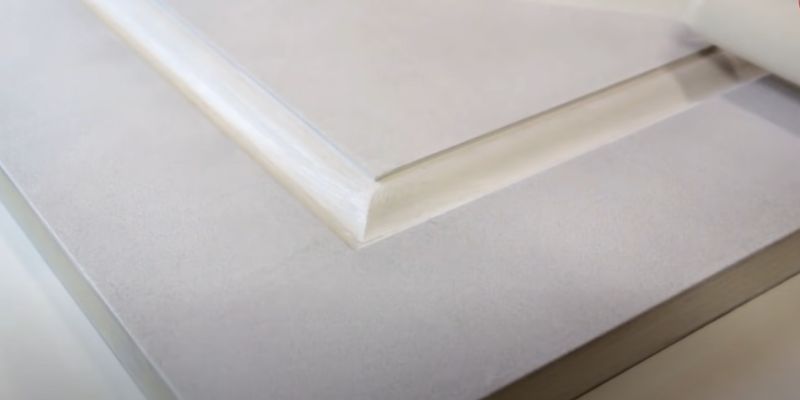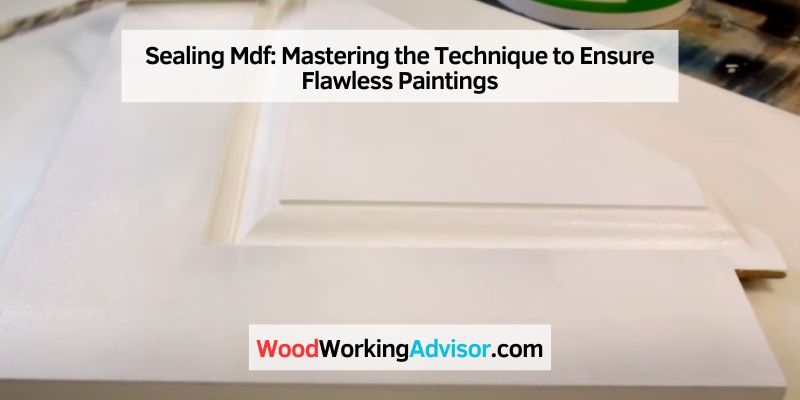To seal MDF before painting, apply a coat of primer that is specifically formulated for MDF. This will help to create a smooth and even surface for the paint to adhere to.
Sealing MDF before painting is an important step to ensure a professional and long-lasting finish. MDF, or Medium Density Fiberboard, is a popular choice for many projects due to its affordability and versatility. However, MDF is more porous than other types of wood, which can make it prone to absorbing moisture and paint unevenly.
By applying a primer designed for MDF, you can seal the surface and provide a stable base for the paint. In this blog post, we will explore the steps to properly seal MDF before painting, as well as some tips and tricks for achieving the best results.
What Is Mdf?
MDF, which stands for Medium-Density Fiberboard, is a versatile and commonly used engineered wood product. It is created by combining wood fibers with resin and then applying high heat and pressure to form panels. MDF is renowned for its affordability, durability, and ease of use in various applications.
Composition Of Mdf
MDF is made by breaking down hardwood or softwood residuals into wood fibers. These fibers are then combined with a resin binder and wax, forming a mixture that is spread across a mat. Heat and pressure are applied to compress the materials together, resulting in a dense, uniform, and smooth panel made entirely of wood fibers.
Characteristics Of Mdf
MDF possesses unique characteristics that make it suitable for a wide range of projects. Understanding these features can help you make informed decisions when it comes to sealing and painting MDF.
- Smooth Surface: MDF has a consistently smooth surface, which makes it ideal for painting and finishing. The surface takes paint well, ensuring a uniform and professional-looking finish.
- Uniform Density: Unlike natural wood, MDF has a uniform density throughout its composition. This means that there are no knots, grain patterns, or voids to contend with, resulting in a more consistent and predictable material for painting.
- Moisture Resistance: Although MDF is prone to swelling and warping when exposed to moisture, it can still be used in areas with controlled humidity levels. Properly sealing MDF before painting helps protect it from moisture-related issues.
- Easy to Cut and Shape: MDF is easy to machine, cut, and shape, making it a popular choice for various woodworking and construction projects. Its consistency allows for precise and intricate designs.
- High Stability: Due to its uniform density and composition, MDF exhibits high stability compared to solid wood. This stability translates to less expansion and contraction due to changes in humidity and temperature.
- Cost-effective: One of the most appealing aspects of MDF is its affordability. Compared to solid wood or other engineered wood products, MDF offers a cost-effective alternative without compromising on quality.

Importance Of Sealing Mdf
When it comes to working with MDF (Medium Density Fiberboard), sealing it before painting is absolutely crucial. Sealing MDF serves three important purposes: preventing moisture damage, reducing fiber swelling, and enhancing paint adhesion. By sealing MDF properly, you can ensure that your painted finish looks professional and lasts for a long time.
Preventing Moisture Damage
MDF is a porous material that absorbs moisture easily. This can result in the expansion and warping of MDF when exposed to water or high humidity. By sealing the surface of MDF, you create a barrier that prevents moisture from penetrating into the board. This helps in maintaining the structural integrity of the MDF and avoids any damage caused by moisture.
Reducing Fiber Swelling
When MDF comes into contact with moisture, the fibers swell up, causing the surface to become uneven and rough. Sealing not only prevents moisture absorption but also reduces fiber swelling. This ensures that the surface of the MDF remains smooth and even, providing a better canvas for painting and achieving a flawless finish.
Enhancing Paint Adhesion
One of the major advantages of sealing MDF is that it enhances paint adhesion. MDF has a smooth surface that does not allow paints to adhere properly. By applying a sealer, you create a textured surface that promotes better adherence of the paint. This results in a more durable and long-lasting painted finish on your MDF project.
Types Of Sealants
When it comes to sealing MDF before painting, there are several types of sealants to choose from. These sealants help to prevent the MDF from absorbing moisture, resulting in a smoother and more durable paint finish. Here are four commonly used types of sealants:
Primer
A primer is an essential step in the sealing process for MDF. It acts as a bonding agent between the surface of the MDF and the paint, ensuring better adhesion. Additionally, primer helps to block the absorption of moisture into the MDF, reducing the chance of warping or swelling.
Pva Sealer
PVA (polyvinyl acetate) sealer is commonly used as a sealant for MDF. It helps to create a smooth surface by filling in any small pores or imperfections in the MDF. PVA sealer also acts as a moisture barrier, preventing the paint from being absorbed unevenly and improving the overall durability of the paint finish.
Shellac
Shellac is another popular sealant option for MDF. It is a natural resin that provides excellent adhesion and seals the surface of the MDF effectively. Shellac dries quickly and creates a hard and protective coating that ensures the paint adheres properly and lasts longer.
Acrylic Medium
Acrylic medium is not only a sealant but also a versatile addition to the painting process. It can be mixed with the paint to enhance its flow and adhesion, as well as improve the paint’s durability. Acrylic medium is especially useful when painting intricate designs on MDF, as it helps to maintain crisp lines and prevent bleeding.
Step-by-step Guide To Sealing Mdf
Learn how to properly seal MDF before painting with this step-by-step guide. Follow these instructions to ensure a smooth and even finish for your MDF projects.
If you’re planning to paint MDF (Medium Density Fiberboard) surfaces, it’s crucial to apply a sealant beforehand to ensure that the paint adheres correctly and provides a smooth finish. Sealing MDF helps to prevent the material from absorbing too much moisture, which can cause it to swell or warp. In this step-by-step guide, we will walk you through the process of sealing MDF, ensuring your painting project turns out beautifully.
Preparing The Surface
- Clean the MDF surface thoroughly to remove any dust, debris, or grease that may be present. Use a damp cloth or sponge with mild soap or detergent to wipe down the surface gently.
- Allow the MDF to dry completely before proceeding to the next step. This ensures that the sealant will adhere properly to the surface.
- Inspect the MDF for any visible imperfections, such as rough edges or dents. Sand these areas lightly with fine-grit sandpaper to create a smooth surface.
Applying The Sealant
- Choose a suitable sealant for MDF, such as a water-based primer or a dedicated MDF sealer. These options provide effective protection against moisture.
- Use a high-quality paintbrush or a paint roller to apply an even coat of sealant to the entire MDF surface. Ensure thorough coverage, paying attention to corners and edges.
- Allow the sealant to dry according to the manufacturer’s instructions. This typically takes around 2-3 hours, but drying times may vary depending on the product and environmental conditions.
Sanding And Recoating
- Once the sealant has dried, gently sand the MDF surface with fine-grit sandpaper. This step helps to smooth out any roughness or brush marks left by the sealant.
- Remove the sanding dust by wiping the surface with a clean, lint-free cloth or vacuuming it with a soft brush attachment.
- If desired, you can repeat the process of applying another coat of sealant for added protection. This step is especially recommended for MDF objects that will be exposed to moisture or heavy use.
By following this step-by-step guide, you can effectively seal your MDF surfaces before painting, ensuring a flawless finish and enhanced durability. Sealing MDF not only helps to protect the material from moisture-related issues but also improves the overall longevity and appearance of your painted projects.

Tips And Tricks For A Flawless Finish
When it comes to sealing MDF before painting, following the right techniques and using the proper tools can make a significant difference in achieving a flawless finish. In this section, we will cover some valuable tips and tricks to help you achieve the best results.
Using Proper Brushes Or Rollers
Choosing the right brush or roller for sealing MDF is essential to ensure smooth and even application. Synthetic bristle brushes or foam rollers work well for this task. These tools are designed to provide better control and minimize the appearance of brush strokes or roller marks on the surface.
When using a brush, make sure to apply the sealant in long, even strokes, moving in the direction of the wood grain. For rollers, use a tray to evenly distribute the sealant and apply it with consistent pressure. By using the right brushes or rollers, you can achieve a professional-looking finish on your MDF.
Ensuring Even Application
One of the keys to a flawless finish when sealing MDF is to ensure even application of the sealant. Uneven application can lead to variations in the color and texture of the painted surface, which can be visually unappealing. To achieve an even application, follow these steps:
- Start by thoroughly stirring the sealant to ensure a consistent consistency.
- Apply the sealant in thin coats rather than one thick layer. This allows for better absorption and prevents the formation of drips or puddles.
- For larger surfaces, work in smaller sections to ensure complete coverage.
By taking these steps and ensuring even application, you can achieve a seamless finish when painting your MDF.
Allowing Sufficient Drying Time
Proper drying time between coats is crucial to achieving a flawless finish when sealing MDF. Rushing the process can result in the sealant not fully drying, which can cause issues such as adhesion problems or a rough texture. Follow these guidelines for allowing sufficient drying time:
- Refer to the manufacturer’s instructions for the recommended drying time of the sealant.
- Ensure that the room is well-ventilated to aid in the drying process.
- Wait until the sealant is completely dry to the touch before applying additional coats.
By allowing sufficient drying time, you can ensure that each layer of sealant properly sets and creates a smooth surface for painting.
Sanding Between Coats
Sanding between coats is an essential step for achieving a flawless finish when sealing MDF. This process helps remove any imperfections or roughness in the surface, resulting in a smoother final result. Follow these steps when sanding between coats:
- Use fine-grit sandpaper (such as 220-grit) to gently sand the surface.
- Wipe away any dust or debris with a tack cloth before applying the next coat.
- Ensure that the surface is completely smooth before proceeding with the next coat of sealant.
Sanding between coats helps create a perfectly smooth surface, ensuring a flawless finish when painting your MDF.
Conclusion
Sealing MDF before painting is an essential step to achieve a professional and durable finish. By following the proper techniques and using the right sealants, you can prevent moisture damage, improve paint adhesion, and ensure the longevity of your MDF projects.
Remember to sand the surface, apply a primer, and seal the edges properly. With these guidelines in mind, you can confidently create beautiful and long-lasting painted MDF creations.


